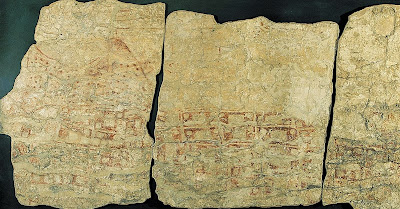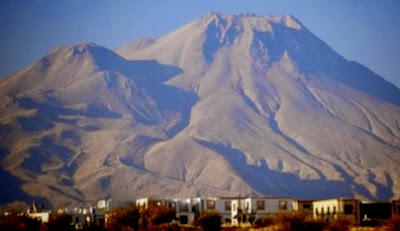
Ancient mural may be first picture of volcanic blast
Was humanity's first depiction of a volcanic eruption daubed on the wall of a house in Turkey 8500 years ago? Geological evidence now supports this controversial claim.
 |
| The inhabitants of Catalhoyuk may have seen Hasan Dag erupt [Credit: Images and Stories/Alamy] |
In 1963, archaeologist James Mellaart found a large mural on the wall of a house in Catalhoyuk, the largest known Stone Age town. He interpreted it as depicting a plan layout of the town's dwellings with a twin-peaked volcano, Hasan Dag, looming behind – captured dramatically in the process of erupting.
If correct, the interpretation makes the mural the earliest depiction of a geological observation.
But not everyone agrees with Mellaart, partly because there was no evidence that Catalhoyuk's people saw Hasan Dag erupt, says Axel Schmitt, a volcanologist of the University of California in Los Angeles.
Now Schmitt and his colleagues have found that evidence, and are presenting their work at the Geological Society of America conference in Denver, Colorado today. They climbed Hasan Dag and collected samples from layers of pumice, a volcanic rock formed during an explosive eruption. By extracting zircon crystals from the pumice and using radiometric dating, they confirm that the rocks are about 9000 years old – roughly the same age as the mural.
 |
| Is it a volcano or is it leopard skin? Or is it both? [Credit: Images and Stories/Alamy] |
What's more, the geological evidence suggests the mural was a relatively accurate depiction of the eruption, says Schmitt. Previous interpretations of the image by volcanologists have suggested it was a small "Strombolian" eruption, he says, characterised by the ejection of bright cinder particles and chunks of molten rock tens of metres above the crater. "The available volcanological evidence is in accordance with this interpretation."
"It is encouraging to see that an eruption may have taken place at Hasan Dag within the time frame of the Catalhoyuk culture," says Haraldur Sigurdsson, a volcanologist at the University of Rhode Island, Narragansett. "I have all along been inclined to believe Mellaart's original interpretation – it is such a good story."
That is the problem, though, says Stephanie Meece, who studied the Catalhoyuk mural while at the University of Cambridge. She concluded that the "volcano" is in fact a depiction of a leopard skin, and the "town" beneath merely a collection of abstract shapes – which was, in fact, Mellaart's original impression.
 |
| Hasan Dag volcano in Turkey erupted 9,000 years ago. The blast is depicted in the oldest known painting of a volcanic eruption [Credit: Janet Harvey and Felix Wicke] |
"It may look like a Strombolian-style eruption to modern-day geologists. But it looks absolutely like a leopard skin," says Meece. Other art at Catalhoyuk shows that the people who lived there were obsessed with wild animals, she says, and that they painted them often. None of their other artworks have been interpreted as landscapes or volcanoes.
Schmitt says the geological evidence is still important, and speculates on a possible compromise. "Zoomorphism could satisfy both interpretations," he says. "Hasan Dag could be seen as the 'leopard mountain'."
Author: Colin Barras | Source: NewScientist [30-10-2013]
Elérhetőség
www.gazdtort.com
PTE BTK TTI Ókortörténeti TanszékH-7624 Pécs, Rókus u. 2.
+36-72-503600-23522